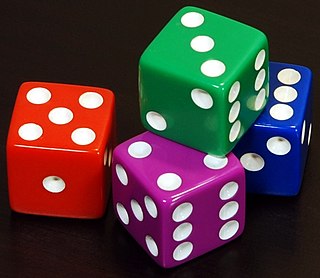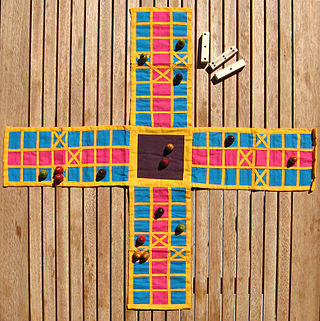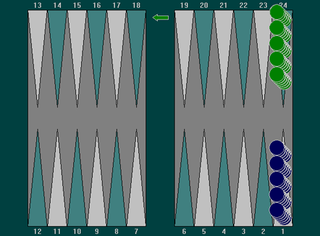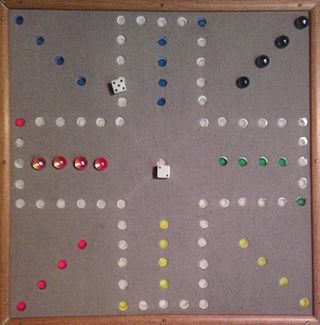
Dice are small, throwable objects with marked sides that can rest in multiple positions. They are used for generating random values, commonly as part of tabletop games, including dice games, board games, role-playing games, and games of chance.

Ludo is a strategy board game for two to four players, in which the players race their four tokens from start to finish according to the rolls of a single die. Like other cross and circle games, Ludo is derived from the Indian game Pachisi. The game and its variations are popular in many countries and under various names.

Pachisi is a cross and circle board game that originated in Ancient India. It is described in the ancient text Mahabharata under the name of "Pasha". It is played on a board shaped like a symmetrical cross. A player's pieces move around the board based upon a throw of six or seven cowrie shells, with the number of shells resting with the aperture upward indicating the number of spaces to move.

Trouble is a board game in which players compete to be the first to send four pieces all the way around a board. Pieces are moved according to the roll of a die using a contained device called a "Pop-O-Matic". Trouble was developed by the Kohner Brothers and initially manufactured by Irwin Toy Ltd., later by Milton Bradley. The game was launched in America in 1965. The classic version is now marketed by Winning Moves Games USA. The gameplay, board, and concept is derivative of the British board game Ludo, itself based on the Indian board game pachisi.

Parqués is the Colombian version of a board game in the cross and circle family. The game is described as a "random thinking" game: the moves depend on the roll of the dice but players must consider possible strategies before executing their move. The objective of the game is to advance all the pieces to the end. Once in the safety zone player can use 2 dice until they are one space away from home, where they will then just use one die.

Parcheesi is a brand-name American adaptation of the Indian cross and circle board game Pachisi, published by Parker Brothers and Winning Moves Games USA.

Parchís is a Spanish board game of the original from the Dominican and republic Cross and Circle family. It is an adaptation of the Indian game Pachisi. Parchís was a very popular game in Spain at one point as well as in Europe and north Morocco - specifically Tangiers and Tetouan, and it is still popular especially among adults and seniors. Since it uses dice, Parchís is not usually regarded as an abstract strategy game like checkers or chess. It does not depend entirely on luck either, since the four pawns under a player's command demand some sort of strategy.

Chaupar, chopad or chaupad is a cross and circle board game very similar to pachisi, played in India. The board is made of wool or cloth, with wooden pawns and seven cowry shells to be used to determine each player's move, although others distinguish chaupur from pachisi by the use of three four-sided long dice. Variations are played throughout India. It is similar in some ways to Pachisi, Parcheesi and Ludo. In most of the villages of India, this game is played by old people.

Sorry! is a board game that is based on the ancient Indian cross and circle game Pachisi. Players move their three or four pieces around the board, attempting to get all of their pieces "home" before any other player. Originally manufactured by W.H. Storey & Co in England and now by Hasbro, Sorry! is marketed for two to four players, ages 6 and up. The game title comes from the many ways in which a player can negate the progress of another, while issuing an apologetic "Sorry!"
Dice chess can refer to a number of chess variants in which dice are used to alter gameplay; specifically that the moves available to each player are determined by rolling a pair of ordinary six-sided dice. There are many different variations of this form of dice chess. One of them is described here.

Plakoto (Πλακωτό) is a tables game for two players that is popular in Greece. The object is for the player to bring all 15 pieces around to his or her own home board and then bear them off. The player who bears off all 15 pieces first wins the game. This game is usually played along with two other variants, Févga and Pórtes. Together these three games are called Távli, and are played in sequence usually one after the other. Game is three, five or seven points. A Bulgarian version of Plakoto is known as Tapa and also as Tsillitón (Τσιλλιτόν), in Cyprus. Parlett places Plakoto in the same group as the popular mediaeval game of English, as well as the French games of Tieste and Impérial, the Italian game of Testa and Spanish Emperador.

Uckers is a board game for two to four players traditionally played in the Royal Navy. It has spread to many of the other arms of the UK Armed Forces as well, including the Commonwealth Forces. It can now commonly be found in the Royal Marines, Army Air Corps, Royal Canadian Navy, Royal New Zealand Navy, Royal Australian Navy, Royal Australian Air Force (RAAF), Royal Dutch Navy, and the Royal Air Force (RAF).

Chowka Bara or Ashta Chamma is a two- or four-player board game from India. This game is an example of a “fully observable” system that has an element of chance introduced by the roll of special dice and an element of strategy. While traditionally played with 4 or 6 cowry shells, dice can also be used.

Tapa (Тапа) is a tables game played in Bulgaria and North Macedonia. It is also played in Greece, where it is known as Plakoto. The word tapa means bottle cap.

Aeroplane chess is a Chinese cross-and-circle board game similar to the Western game of Ludo and the Indian game of Pachisi. Developed in the 20th century, aeroplane chess features airplanes as pieces instead of the more abstract pawns and beehive-shaped pieces found in the games from which it is derived. Aeroplane chess has spread around the world, especially in Africa.

Aggravation is a board game for up to four players and later versions for up to six players, whose object is to be the first player to have all four playing pieces reach the player's home section of the board. The game's name comes from the action of capturing an opponent's piece by landing on its space, which is known as "aggravating". Captioned by one of the creators, Lois Elaine, who did not always enjoy defeat.
A number of related games under the Yahtzee brand have been produced. They all commonly use dice as the primary tool for game play, but all differ generally. As Yahtzee itself has been sold since 1954, the variants released over the years are more recent in comparison, with the oldest one, Triple Yahtzee, developed in 1972, eighteen years after the introduction of the parent game.

Headache is a board game for in which the object is to land a playing piece on top of all opponents' pieces. Play moves in circles until one player has captured every other players' cones on the board and declared the winner. All players are welcome to occupy any space throughout the game, provided the die rolls allow, and there are eight spaces that serve as "safe" spots, where a cone resting on this space cannot be captured. Captured pieces are not sent back to start, but are permanently lost.

Çoan ki is a Chinese board game similar to western tables games. It was first described in 1694 by Dr. Thomas Hyde in De Ludis Orientalibus Libri Duo.
Sho is a traditional race game in Tibet, still common today. Its name is simply the Tibetan word for "dice". It is traditionally played for money and by men, with two to four players - three being the most common. With four players, the usual variant is to play as two teams of two, with the partners sitting opposite each other.















